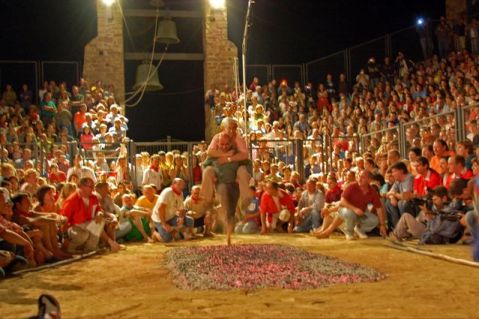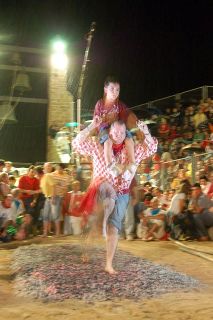The Religion, Cognition and Culture (RCC) research group (Faculty of Theology), the Centre for Functional Integrative Neuroscience (CFIN) and Danish Pain Research Center (DPRC) (both at Århus University Hospital), University of Aarhus are sending a team of scientists to study a Spanish fire-walking ritual as it happens.
RCC Doctoral candidate Uffe Schjødt and RCC Fellow Dimitris Xygalatas have put together a great international team of interdisciplinary scholars, which will be traveling to San Pedro Manrique in Spain to study the fire-walking rituals of San Juan. This revolutionary expedition will use different measuring instruments in order to answer a series of questions about such high-arousal rituals.
| In a small Spanish village called San Pedro Manrique, firewalking is performed once a year. There, the participants meet every 23rd of June, in the summer solstice, to hold the ritual as part of the festival of San Juan, which lasts 8 days. The festival includes a whole range of events including public dancing, horse riding, music and communal meals, a Eucharist, and processions with the icons and statues of San Pedro, patron of the village, and the Virgin Mary. |  The participants carry a person on their back as they go through the fire in front of the ecstatic crowd. The participants carry a person on their back as they go through the fire in front of the ecstatic crowd. |
Firewalking is performed on the night of the 23rd, exactly at midnight. An amphitheatre has been built outside the village specifically for this purpose. It can accommodate almost 3000 people, while the village’s population is 800 people. It includes a chapel, where the statues of the saints are kept, and a central stage, where fire-walking is performed.
The fire is made from oak wood, which produces a very high temperature. The stake burns for many hours until it is finally reduced to a carpet of glowing red coals. It is about 7 metres long and 20-30cm deep, and the participants walk through it carrying a person on their back.
 Even under heavy rain, the coals are still glowing red, with temperatures reaching up to 600 degrees Celcius. | What is particularly interesting about this ritual is that not all of the participants are religiously motivated; it is practiced both by religious and non-religious people. Furthermore, these people have the same cultural background, since only locals can take part. There is even a case of two brothers performing the ritual, one brother being very religious while the other is an atheist. One claims that fire-walking is a miracle, while the other one argues that anyone can do it. The team will use various methods to study the participants’ levels of physiological and emotional arousal, varying from heart rate to hormone levels, as well the study of facial expressions during the performance of the fire-walking ritual. Some of the main questions they will try to answer are: What are the effects of such intense rituals on a physiological and emotional level?Are there differences between the religious and non-religious participants? Does performing the ritual change people’s perception of pain? Does arousal correlate with episodic memory for such rituals? How about the observers of the ritual? Do they have similar responses to those of the firewalkers? |
Dimitris Xygalatas has done preliminary fieldwork in San Pedro Manrique, and the fire-walkers are looking forward to welcoming the team and seeing the results of the study. There will be wide media coverage for the event, and the final results of the expedition will be published in scientific journals. The team will also publish a blog-diary which will be made available through this website.
The expedition is funded by the Centre for Functional Integrative Neuroscience (CFIN), the Aarhus Research Foundation, the Faculty of Theology, and the Aarhus Pain Research Centre, while Polar, the world’s leading manufacturer of sports instruments, is also contributing with their precision heart-rate monitors.
More to come!